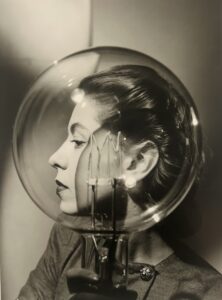
Lee Miller is almost impossible to define in words. To label her a storyteller seems too simplistic. Variously a photographer, artist, model, and socialite, she excelled in everything she put her mind to. The legendary American is currently being honoured by a huge retrospective at London’s Tate Britain gallery.
Born in 1907 in Ploughkeepsie, New York, Miller began her career as a model in New York aged 19 in 1926, whilst studying painting. By March 1927, she was on the covers of both US and UK Vogue, and was one of the most successful models of the time. Having decided she would rather take a picture than be in one, she retrained as a photographer and moved to Paris in 1929. There she met and worked with both Man Ray and George Hoyningen-Huene, two of the best photographers of the era. She learnt a lot from both of them, collaborating particularly closely with Man Ray. Their very sexually-charged self-portraits feature at the beginning of the show and are one of its highlights. Miller actually invented the photographic technique of solarisation, often credited to Man Ray, by accidentally turning on the dark room lights while some negatives were still being developed.
Back in New York in early 1932 she launched her own photographic studio, and further developed her style for strange, often surreal imagery, often with underlying themes of power and danger. The demands of running a commercial studio didn’t, however, sit well with her and by 1934 she was living in Cairo with a new Egyptian husband. Over the next four years she shot work across Egypt, Syria, Palestine, Lebanon and south-eastern Europe. The next room highlights this work, beautiful, minimal and evocative. She had no darkroom then so used a local Kodak print shop to develop her work.
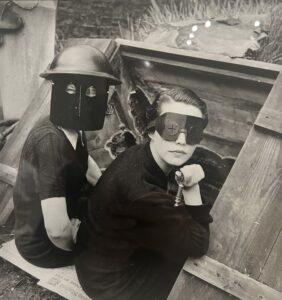 |
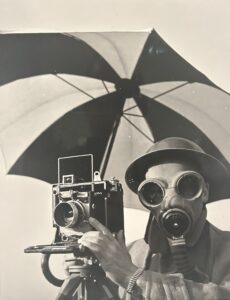 |
The late 1930s/early 1940s saw Miller focus on portraiture. She had an amazing circle of creative friends, including Picasso, Charlie Chaplin, Colette, Jean Cocteau and so on. She was very prolific, amassing over a thousand images alone of her dear friend Picasso. These images of her crowd are amongst my favourites. You can imagine the conversations and soirees.
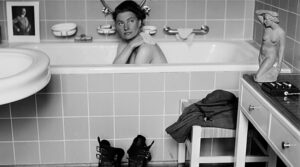 World War Two saw her in London working as the war correspondent for Vogue. She worked right through the Blitz. She excelled at this and added a stylish twist to the British war effort, helping to keep morale high. Vogue encouraged women to enter the workforce and helped with tips on rationing etc. Miller actually wanted to work closer to the front line but wasn’t allowed to. This frustrated her, so when she got the chance to photograph the liberation of a couple of the German concentration camps – Buchenwald and Dachau – she jumped at the chance. The resulting photographs of piles of dead bodies, skeletal survivors and bloodied former SS guards are harrowing. The iconic self-portrait of Miller sitting in Hitler’s bath is included in this section. This work may, however, have proved Miller’s undoing as she largely abandoned photography a few years after the war. She returned to England and held court between London and Farley’s House, a country home in Sussex. She had a son and got into gourmet cooking. She suffered mental health issues and drank too much alcohol, keeping quiet about her past career. Even her son never knew about her amazing photographic career until she died, by suicide, in 1977, aged 70.
World War Two saw her in London working as the war correspondent for Vogue. She worked right through the Blitz. She excelled at this and added a stylish twist to the British war effort, helping to keep morale high. Vogue encouraged women to enter the workforce and helped with tips on rationing etc. Miller actually wanted to work closer to the front line but wasn’t allowed to. This frustrated her, so when she got the chance to photograph the liberation of a couple of the German concentration camps – Buchenwald and Dachau – she jumped at the chance. The resulting photographs of piles of dead bodies, skeletal survivors and bloodied former SS guards are harrowing. The iconic self-portrait of Miller sitting in Hitler’s bath is included in this section. This work may, however, have proved Miller’s undoing as she largely abandoned photography a few years after the war. She returned to England and held court between London and Farley’s House, a country home in Sussex. She had a son and got into gourmet cooking. She suffered mental health issues and drank too much alcohol, keeping quiet about her past career. Even her son never knew about her amazing photographic career until she died, by suicide, in 1977, aged 70.
This is a beautiful show that covers all human emotions. Lee Miller truly lived nine lives, all at the highest possible level. The powerful images and narrative will remain etched on your mind, so don’t miss it.
|
|
|
| Tate BritainExhibition
Lee Miller |
| Queerguru’s Contributing Editor Ris Fatah is a successful fashion/luxury business consultant (when he can be bothered) who divides and wastes his time between London and Ibiza. He is a lover of all things queer, feminist, and human rights in general. @ris.fatah |


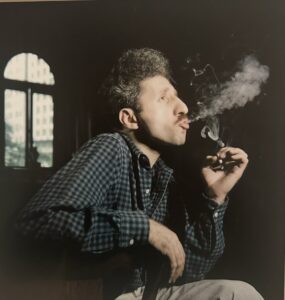
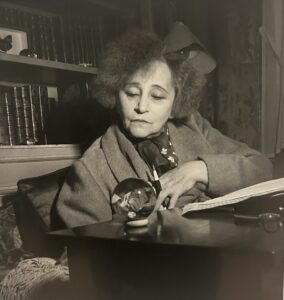
Leave a Reply